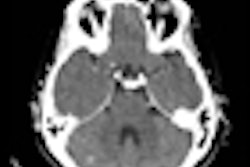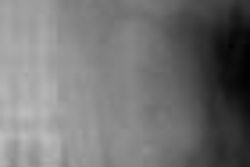A computer-aided detection (CAD) algorithm designed to find polypoid lesions of the colon also does fairly well at finding frank cancers, researchers from the U.K. concluded. But sensitivity varies depending on the system settings and the quality of the prep.
CAD algorithms "were developed to detect polyps in the context of screening, but we really don't know much about how they work in the context of symptomatic cancer patients," said Charlotte Robinson at the 2009 European Congress of Radiology (ECR) in Vienna. So the researchers sought to "determine whether a CAD system primarily developed to detect polyps performs sufficiently well for the detection of colorectal cancer," she said.
In the U.K., where larger numbers of patients compared with the U.S. present with advanced disease at screening, CAD might be needed to detect a cancer that would otherwise be missed.
Robinson, Dr. Stuart Taylor et al from University College Hospital and University College London, along with colleagues from hospitals in China and Japan, performed a six-center retrospective study of 132 patients (mean age, 68 years) with suspected colorectal cancer. All were eventually diagnosed with histology-proven colorectal carcinoma.
MDCT virtual colonoscopy had been performed in each using a standard technique, but with variable bowel preparation methods, Robinson said.
The DICOM CT data were uploaded to a PC workstation for evaluation by a proprietary CAD algorithm (Colon CAD 3.1, Medicsight, London).
The CAD algorithm was applied to each dataset at four sphericity settings (0, 50, 75, 100). "Seventy-five was the default manufacturer's setting, 100 [highest sphericity] detected a more curvy polypoid shape, and a single observer characterized all of the CAD marks," Robinson noted.
The reader classified individual CAD prompts as true positive if related to a cancer or false positive if found anywhere else on the dataset (including those on true polyps). Colonoscopy data were used to aid in lesion matching. A total of 132 cancers were detected; results are broken down by sphericity filter setting in the table below.
|
Many of the datasets were from patients who were poorly prepped, Robinson said.
Fully 43% of the cancers were found in only one scan position, prone or supine. Twelve of the patients were scanned only in the supine position.
"Of the single acquisitions, more cancers were picked up on the prone imaging, and that goes with what you'd expect because most cancers were in the rectosigmoid, and that region is better distended, usually, on the prone images," she said.
The results were heavily dependent on CAD sphericity settings and the perceived bowel preparation, so that lower sphericity and poorer bowel prep increased the number of false positives, Robinson said. Specificity decreased slightly, from 84% to 79%, as sphericity settings decreased from 75 to 0.
"Although the CAD algorithm used wasn't specifically designed for picking up colorectal cancer, it's reasonably good at picking them up," Robinson said. "The detection of cancer increases with decreasing sphericity, at the expense of decreasing specificity."
By Eric Barnes
AuntMinnie.com staff writer
April 3, 2009
Related Reading
Adding CAD to virtual colonoscopy saves lives and money, February 24, 2009
Virtual colonoscopy beginners do better with 3D data, February 5, 2009
Image tools cut false positives in unprepped VC, August 4, 2008
Radiographers perform VC with CAD -- and controversy, June 24, 2008
VC CAD improves results for readers at all levels, April 7, 2006
Copyright © 2009 AuntMinnie.com



















